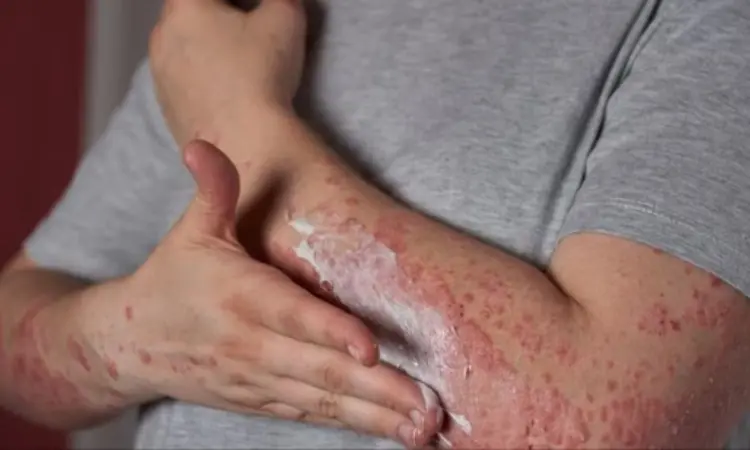- Home
- Medical news & Guidelines
- Anesthesiology
- Cardiology and CTVS
- Critical Care
- Dentistry
- Dermatology
- Diabetes and Endocrinology
- ENT
- Gastroenterology
- Medicine
- Nephrology
- Neurology
- Obstretics-Gynaecology
- Oncology
- Ophthalmology
- Orthopaedics
- Pediatrics-Neonatology
- Psychiatry
- Pulmonology
- Radiology
- Surgery
- Urology
- Laboratory Medicine
- Diet
- Nursing
- Paramedical
- Physiotherapy
- Health news
- Fact Check
- Bone Health Fact Check
- Brain Health Fact Check
- Cancer Related Fact Check
- Child Care Fact Check
- Dental and oral health fact check
- Diabetes and metabolic health fact check
- Diet and Nutrition Fact Check
- Eye and ENT Care Fact Check
- Fitness fact check
- Gut health fact check
- Heart health fact check
- Kidney health fact check
- Medical education fact check
- Men's health fact check
- Respiratory fact check
- Skin and hair care fact check
- Vaccine and Immunization fact check
- Women's health fact check
- AYUSH
- State News
- Andaman and Nicobar Islands
- Andhra Pradesh
- Arunachal Pradesh
- Assam
- Bihar
- Chandigarh
- Chattisgarh
- Dadra and Nagar Haveli
- Daman and Diu
- Delhi
- Goa
- Gujarat
- Haryana
- Himachal Pradesh
- Jammu & Kashmir
- Jharkhand
- Karnataka
- Kerala
- Ladakh
- Lakshadweep
- Madhya Pradesh
- Maharashtra
- Manipur
- Meghalaya
- Mizoram
- Nagaland
- Odisha
- Puducherry
- Punjab
- Rajasthan
- Sikkim
- Tamil Nadu
- Telangana
- Tripura
- Uttar Pradesh
- Uttrakhand
- West Bengal
- Medical Education
- Industry
Poor neighbourhood may predict severe skin lesions in discoid lupus erythematosus: JAMA

Researchers have found that socioeconomic and behavioral factors are of prime importance in the severity of discoid lupus erythematosus among the residents of Philadelphia. A recent study by Katharina S. Shaw, MD, and colleagues from the University of Pennsylvania added that people living in areas marked by poverty tended to have greater severity in manifestations of DLE; however, associations with racial identity were relatively weak after adjustment for socioeconomic factors. This study was published in JAMA Dermatology.
This study reviewed data on 154 adult DLE patients seen at the University of Pennsylvania's rheumatology-dermatology specialty clinic from 2007 to 2024. This was a cross-sectional analysis in which SES disadvantage was measured via the area deprivation index. ADI combines 17 neighborhood-level data points measuring education, employment, housing quality, and indicators of wealth into one index value from 1 to 10, with greater values indicating greater socioeconomic disadvantage.
Key Findings
• Among the 154 patients, 64% were Black, and 30% were white. At their first clinic visit, about one-quarter had moderate-to-severe disease activity, and three-quarters had moderate-to-severe damage.
• The mean ADI rating for Black patients was 6.8, compared to 2.7 for white patients.
• The odds of showing moderate to severe skin damage (CLASI-D ≥6) were roughly quadrupled among residents of census blocks with an ADI score greater than 5 compared with blocks rated at 5 or less (OR 3.90, 95% CI 1.27-12.69).
• Odds of high CLASI scores for disease activity (CLASI-A ≥10) were strongly associated with ADI values greater than 5 (OR 3.31, 95% CI 1.27-9.44).
• Initially, 87% of Black patients were characterized as having moderate-to-severe disease compared with 52% of white patients (P<0.001).
• After adjusting for ADI and other confounders, race was not significantly associated with higher CLASI-D severity (OR 2.78, 95% CI 0.95-8.44).
This study shows that SES and behavioral risk factors more strongly relate to poor health status in those with DLE than does racial identity. The bottom line for social policy implications is that already-recognized inequities at the structural level need to be addressed, and a more sophisticated approach—one which embeds a sense of socioeconomic context within which racial disparities are observed—taken toward understanding these issues.
In addition to socioeconomic factors, smoking status and SLE diagnosis were associated with higher disease activity and damage. Odds ratios for moderate-to-severe damage were 3.15 for current smoking and 3.63 for SLE; the odds ratios for moderate-to-severe disease activity were 2.20 and 1.97, respectively, where the latter did not reach statistical significance.
This suggests that smoking cessation programs should be available to all patients with DLE, more importantly in deprived areas. Second, neighborhood deprivation is potentially modifiable. Strategies that may influence this include increasing transportation, such as better access to health facilities, medical trust within the community, better education of patients, and medications should be afforded and easily accessible.
This study makes an explanation of the relationships between the socioeconomic factors and DLE severity, which is rather complex. Racial disparities in severity exist but these could be partially explained by socioeconomic deprivation. Further studies with larger sample sizes are required to further elucidate the association between the components of the ADI and DLE disease severity.
Reference:
Faden, D. F., Xie, L., Stone, C., Lopes Almeida Gomes, L., Le, T., Ezeh, N., Buckingham, W. R., Kind, A., Vleugels, R. A., Werth, V. P., Arkin, L., & Shaw, K. S. (2024). Area deprivation and disease severity in adult patients with discoid lupus erythematosus. JAMA Dermatology (Chicago, Ill.). https://doi.org/10.1001/jamadermatol.2024.2355
Dr Riya Dave has completed dentistry from Gujarat University in 2022. She is a dentist and accomplished medical and scientific writer known for her commitment to bridging the gap between clinical expertise and accessible healthcare information. She has been actively involved in writing blogs related to health and wellness.
Dr Kamal Kant Kohli-MBBS, DTCD- a chest specialist with more than 30 years of practice and a flair for writing clinical articles, Dr Kamal Kant Kohli joined Medical Dialogues as a Chief Editor of Medical News. Besides writing articles, as an editor, he proofreads and verifies all the medical content published on Medical Dialogues including those coming from journals, studies,medical conferences,guidelines etc. Email: drkohli@medicaldialogues.in. Contact no. 011-43720751


